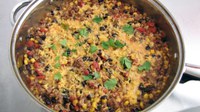Prairie Fare: Be Aware of Grocery Store Psychology
(Click an image below to view a high-resolution image that can be downloaded)
By Julie Garden-Robinson, Food and Nutrition Specialist
NDSU Extension Service
“I think I will curl up by a pallet of baked beans and take a nap,” my husband commented. I think he was in a “food coma.”
My husband and I had just completed a hearty breakfast at a nearby restaurant. We followed our breakfast with a trip to a warehouse-type grocery store.
“I don’t think I need this huge cart. Nothing looks appealing right now,” I noted as I slowly pushed the jumbo grocery cart around the store.
The cart was large enough to fit my tired hubby. That would have been photo-worthy, but he gradually awakened as we shopped.
I often recommend that people have a snack before shopping, but we went overboard with our breakfast. We still needed to buy some food for the week, despite our disinterest in food. We practically ran away from the people offering food samples throughout the store.
I thought I might never be hungry again. However, after a few laps down the long aisles, I managed to pick out some groceries to get us through the week.
Have you ever thought about the psychology of grocery stores? These businesses are not random displays of foods.
Warehouse food stores are a little different from regular grocery stores, and food sampling plays a fairly significant role in promoting food sales. When people have the opportunity to taste a food, they are more likely to purchase that item.
We usually shop at “regular” grocery stores, especially when we need only a small amount of specific items. In many warehouse stores, you do not have the option of buying one can of beans, for example. You usually need to buy a multipack of most foods.
Large grocery stores have thousands of items. The store layout is designed to promote buying more food, sometimes more than you plan to buy.
Usually you arrive at the produce aisle or bakery first. These departments offer sensory appeal with colorful fruits and vegetables or the aroma of freshly baked items. You might find bouquets of fresh flowers near the front of the store, too. I have been enticed to fill a vase for myself, on occasion.
If music is playing, you may walk more slowly based on the tempo of the music. At least one study has shown that music enhances sales; the more you dawdle, the more you buy.
If you want to buy some milk and eggs, you probably need to walk through all the aisles and temptations to reach the dairy case. If you’re like me, a trip through the store often inspires more than milk in my cart.
You might be tempted by the “end caps.” These items are parked at the ends of aisles, which are premium spots that encourage shoppers to purchase foods.
Food marketing researchers have shown that setting a limit on the number you can buy often prompts people to buy the larger number of items. Be aware that when a grocery store sign lists “Two for $1.00,” you usually can buy one item for 50 cents, unless the sign says “must buy two.”
If you have raised children or are in the process of raising them, you also might have noticed that the smiling cartoons on the front of cereal boxes often are at kids’ eye level.
Look at the eyes on the cartoons. When children make “eye contact” with the characters, they are more likely to use their “pester power” to get you to buy the cereal, snack or other item. My oldest child had more success with asking for food than his younger siblings; parents can learn, too.
When you reach the checkout stand, be aware that all the gum, breath mints, magazines, soda pop and assorted items are there to promote impulse purchases as you wait for the person in front of you to unload and pay for his or her groceries.
Be aware of supermarket psychology so you can be a savvy shopper. Plan menus and make a list so you are less likely to need to run to the store for just one or two items.
Visit “The Family Table” website (https://www.ag.ndsu.edu/familytable) for more tips about feeding yourself and/or a family. Sign up for the monthly newsletter and visit the Facebook site, which has prize-winning options.
Here’s a delicious recipe that was a big hit when our student intern tested it recently. Be sure to add these items to your grocery list.
Beef and Rice Mexican Skillet
1 Tbsp. cooking oil
1 large onion, chopped
1 pound lean ground beef
2 c. brown rice, cooked
1 fresh tomato, diced
1 (4-ounce) can green chilies, drained
1 (15-ounce) can black beans, rinsed and drained
2 c. frozen corn
1 (1-ounce) packet low-sodium taco seasoning
1 1/2 c. low-sodium chicken broth
1 c. shredded Colby and Monterey jack cheese, reduced fat
Cilantro for garnish
In a large skillet over medium heat, heat cooking oil. Add onion and cook two minutes, then add ground beef and cook, breaking up with a wooden spoon, until no longer pink, six minutes. Drain fat. Add brown rice to skillet, then add tomatoes, chilies, black beans, corn and taco seasoning packet. Stir to combine, then add chicken broth. Bring to a simmer, cover and cook 20 minutes. Top with 1 cup shredded Colby and Monterey jack cheese and cover to let melt, two to three minutes. Garnish with cilantro and serve.
Makes 10 servings. Each serving has 240 calories, 9 grams (g) fat, 19 g protein, 19 g carbohydrate, 2 g fiber and 410 milligrams sodium.
(Julie Garden-Robinson, Ph.D., R.D., L.R.D., is a North Dakota State University Extension Service food and nutrition specialist and professor in the Department of Health, Nutrition and Exercise Sciences.)
NDSU Agriculture Communication - March 30, 2017
| Source: | Julie Garden-Robinson, 701-231-7187, julie.garden-robinson@ndsu.edu |
|---|---|
| Editor: | Ellen Crawford, 701-231-5391, ellen.crawford@ndsu.edu |



